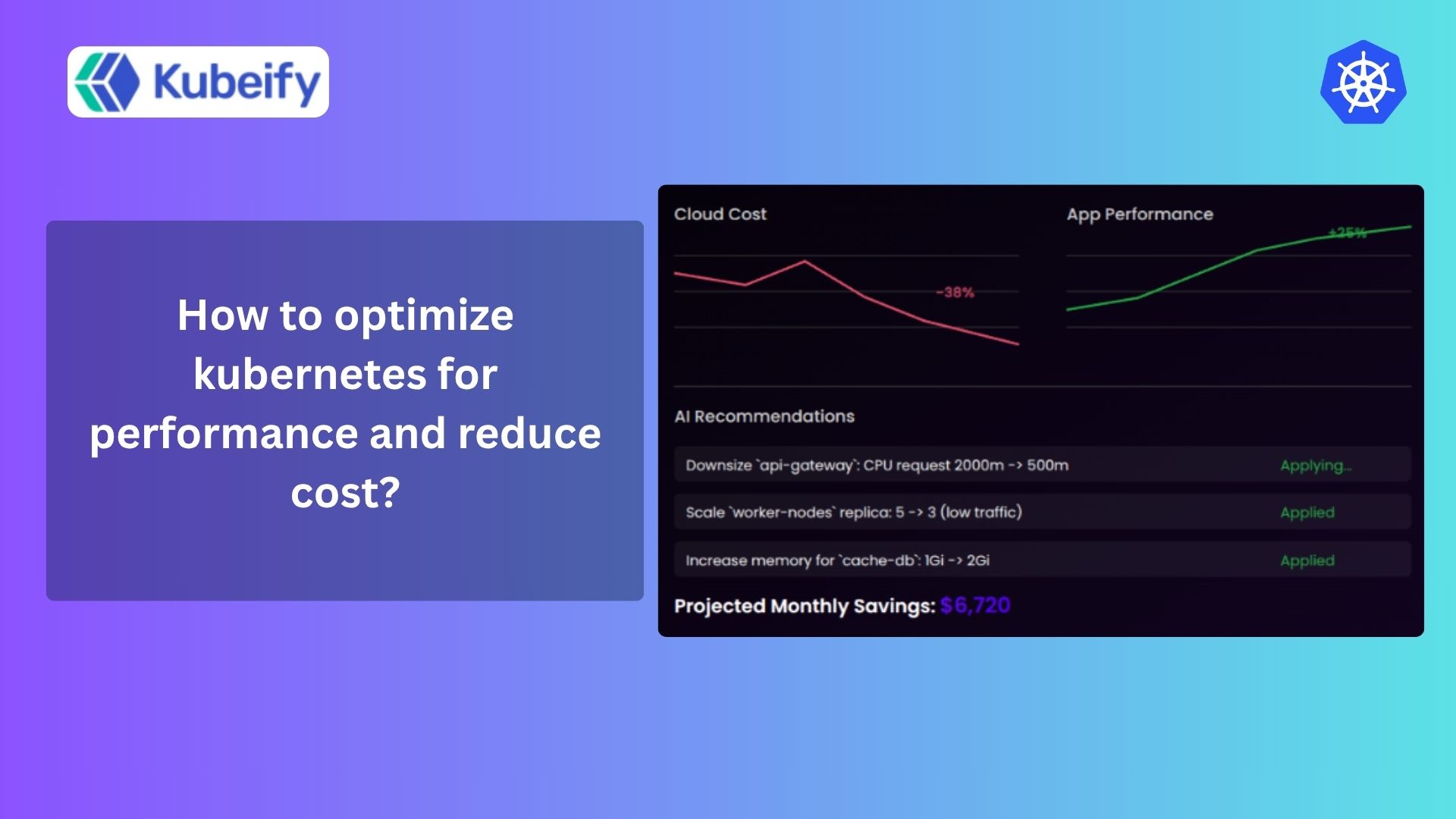Optimizing Kubernetes for both performance and cost reduction involves strategic resource management, efficient scaling, and continuous monitoring. Key approaches include setting precise resource requests and limits, leveraging autoscaling, right-sizing nodes, optimizing storage, and using cost-effective instance types. Below are actionable strategies supported by industry best practices.
Resource Allocation and Limits
Set precise CPU and memory requests to ensure pods receive adequate resources, and define limits to prevent excessive consumption that affects other workloads. Under-provisioning risks performance issues, while over-provisioning wastes resources. Tools like Prometheus or Kubernetes Metrics Server help calibrate these values based on actual usage.
Example deployment configuration:
resources:
requests:
memory: "512Mi"
cpu: "500m"
limits:
memory: "1Gi"
cpu: "1"
Autoscaling
Implement Horizontal Pod Autoscaling (HPA) to dynamically adjust pod replicas based on CPU/memory utilization or custom metrics. Combine with Cluster Autoscaler to add/remove nodes as needed, avoiding idle resources.
Example HPA configuration:
apiVersion: autoscaling/v2
kind: HorizontalPodAutoscaler
spec:
scaleTargetRef:
apiVersion: apps/v1
kind: Deployment
name: your-app
minReplicas: 2
maxReplicas: 10
metrics:
- type: Resource
resource:
name: cpu
target:
type: Utilization
averageUtilization: 60
Node Optimization
- Right-size nodes: Match instance types to workload needs (e.g., memory-optimized for databases, compute-optimized for CPU-heavy apps).
- Use spot instances: Deploy non-critical workloads on spot instances (e.g., AWS Spot) for up to 90% cost savings.
- ARM architectures: Adopt ARM-based nodes (e.g., AWS Graviton) for cost-efficient performance.
Storage and Network Efficiency
- Optimize storage: Select SSD storage for I/O-intensive apps and HDD for cheaper bulk storage. Delete unused Persistent Volumes (PVs) to avoid waste.
- Node Local DNS Cache: Reduce DNS lookup latency and cluster DNS load by enabling local caching.
Workload Distribution and Health
- Pod affinity/anti-affinity: Distribute pods across nodes to minimize resource contention and improve resilience.
- Probes: Use livenessProbe and readinessProbe to ensure only healthy pods serve traffic, reducing downtime.
Cost-Specific Strategies
- Reduce nodes: Lower costs by minimizing idle nodes via Cluster Autoscaler.
- Namespaced quotas: Enforce CPU/memory quotas per namespace to prevent resource monopolization.
- Cleanup unused resources: Audit and remove orphaned PVs, idle load balancers, or stale services.
Deploy tools like Kubecost, CloudZero, or Prometheus to track spending, forecast costs, and identify inefficiencies. Regular reviews ensure configurations align with evolving workload demands.
By combining these techniques—fine-grained resource control, dynamic scaling, infrastructure optimization, and proactive monitoring—Kubernetes environments achieve peak performance while minimizing costs. Continuous iteration based on metrics ensures sustained efficiency as workloads evolve.
##FAQ
- What are the most effective ways to balance resource requests and limits in my cluster?
Balancing resource requests and limits in your Kubernetes cluster is essential for efficient resource utilization, application stability, and cost control. Here are the most effective strategies and best practices:
Rightsize Requests and Limits Based on Actual Usage
- Monitor real-world resource usage: Use Kubernetes monitoring tools (like Prometheus, Metrics Server, or cloud-native solutions) to gather data on CPU and memory consumption. Set requests and limits based on observed usage, not guesses or defaults.
- Iteratively adjust: Start with conservative estimates, deploy, monitor, and incrementally tune requests and limits to match actual needs.
Set Memory Requests Equal to Limits (When Appropriate)
- For memory, it’s often best to set requests and limits to the same value. This avoids unexpected container terminations due to memory spikes and ensures predictable memory allocation, reducing fragmentation and OOM (Out of Memory) errors.
Be Cautious with CPU Limits
- Avoid unnecessary CPU limits: Setting CPU limits can throttle application performance, especially for bursty workloads. Prefer setting CPU requests only, allowing applications to use extra CPU when available, unless you need strict isolation.
Use Horizontal Pod Autoscaling (HPA)
- Implement HPA: Use HPA to automatically scale the number of pod replicas based on CPU, memory, or custom metrics. This helps handle variable workloads without over-provisioning resources.
Align with Workload Priority and Node Capacity
- Prioritize critical workloads: Assign higher requests and limits to mission-critical applications, and lower values to less important or batch jobs[3].
- Consider node resources: Ensure requests are set so that pods can be efficiently scheduled across nodes, avoiding underutilization or scheduling failures.
Use LimitRanges and ResourceQuotas
- Namespace-level controls: Apply LimitRanges to set default/minimum/maximum resource requests and limits for all pods in a namespace. Use ResourceQuotas to cap total resource usage per namespace, ensuring fair resource sharing.
Leverage Kubernetes Quality of Service (QoS) Classes
- QoS classes: Set requests and limits to influence pod QoS (Guaranteed, Burstable, BestEffort). Use Guaranteed for critical apps (requests = limits), Burstable for flexible apps, and BestEffort for non-critical workloads.
Regularly Review and Update
- Continuous optimization: Application needs change over time. Periodically review resource usage and adjust requests and limits to maintain optimal performance and cost-efficiency.
Summary Table: Key Practices
| Practice |
Benefit |
| Rightsize based on real usage |
Prevents waste and resource starvation |
| Set memory requests = limits |
Avoids OOM kills and memory fragmentation |
| Avoid strict CPU limits (when possible) |
Prevents performance throttling |
| Use HPA |
Dynamically matches resources to workload demand |
| Prioritize by workload importance |
Ensures critical apps get needed resources |
| Use LimitRanges/ResourceQuotas |
Enforces fair resource usage at namespace level |
| Leverage QoS classes |
Prioritizes workloads during resource contention |
| Regularly review and tune |
Maintains efficiency as workloads evolve |
By following these strategies, you can achieve a well-balanced, cost-effective, and high-performing Kubernetes cluster.
- How can I optimize requests and limits for better cluster stability?
Optimizing Kubernetes resource requests and limits is critical for cluster stability, preventing resource contention, and ensuring predictable application performance. Below are key strategies supported by industry best practices:
Rightsize Based on Actual Usage
- Monitor real consumption using tools like Prometheus or Kubernetes Metrics Server to set requests at or slightly above average usage (e.g., adding a 15% buffer to observed peaks).
- Avoid static defaults: Iteratively adjust values through load testing and observability, avoiding over-provisioning (resource waste) or under-provisioning (performance degradation).
Memory: Set Requests Equal to Limits
- Prevent OOM terminations: Equal memory requests and limits ensure predictable allocation, reducing fragmentation and unexpected pod kills.
- Example configuration:
resources:
requests:
memory: "512Mi"
limits:
memory: "512Mi"
CPU: Avoid Strict Limits
- Minimize throttling: CPU limits can artificially cap performance during bursts. Prefer setting requests only, allowing pods to access idle CPU resources.
- Exception: Use limits for noisy-neighbor isolation in multi-tenant clusters.
Enforce Namespace-Level Controls
- ResourceQuotas: Cap aggregate CPU/memory per namespace to prevent resource monopolization.
- LimitRanges: Define default requests/limits per namespace to enforce consistency.
Leverage Autoscaling and QoS
- Horizontal Pod Autoscaler (HPA): Dynamically scale replicas based on CPU/memory utilization, maintaining stability during traffic spikes[2][6].
- Quality of Service (QoS): Prioritize critical apps with Guaranteed (requests=limits) and non-critical with Burstable (requests<limits).
Continuous Optimization
- Audit unused resources: Regularly clean up orphaned PVs, idle pods, or stale services.
- Automate rightsizing: Use tools like Vertical Pod Autoscaler (VPA) or Goldilocks to adjust requests/limits based on usage trends.
Stability Optimization Checklist
| Strategy |
Impact on Stability |
| Memory requests = limits |
Prevents OOM kills |
| Avoid CPU limits |
Reduces throttling during bursts |
| ResourceQuotas |
Ensures fair resource allocation |
| HPA + QoS classes |
Maintains performance under variable load |
| Iterative rightsizing |
Aligns resources with evolving workloads |
Implementing these practices—precise rightsizing, memory consistency, CPU flexibility, and automated scaling—creates a resilient cluster where applications receive guaranteed resources without contention. Continuous monitoring and adjustment sustain stability as workloads evolve.
- How can I analyze historical data to set optimal requests and limits?
To set optimal Kubernetes resource requests and limits using historical data, follow these steps:
1. Collect Historical Resource Usage Data
- Use monitoring tools like Prometheus, Metrics Server, or cloud solutions to gather detailed CPU and memory usage metrics over time for each workload.
- Ensure you have a representative dataset that covers typical and peak usage periods, as application behavior may vary with load and time.
2. Analyze Usage Patterns
- Examine metrics dashboards or reports to identify average, peak, and percentile-based usage (e.g., 95th or 99th percentile).
- Look for periodic spikes and sustained high or low usage to understand workload characteristics.
3. Calculate Requests and Limits
- Requests: Set CPU and memory requests based on the average or slightly above-average usage, often using the 95th or 99th percentile for production workloads to ensure stability during peaks.
- Limits: Set limits higher than requests to allow for temporary bursts, but not so high as to risk resource contention. For memory, some recommend setting requests equal to limits for predictability and to avoid OOM kills.
- Add a buffer (e.g., 20–60%) above observed peaks for highly available or critical applications.
4. Validate and Iterate
- Deploy changes and monitor the impact on application performance and cluster stability.
- Adjust values as needed based on new data and evolving workload patterns[2][4][5].
- Use Vertical Pod Autoscaler (VPA) to automatically recommend or adjust requests and limits based on historical usage.
- Leverage cost and efficiency tools (e.g., CAST AI, KubeSphere) for tailored recommendations and ongoing optimization.
Example Workflow
- Export CPU/memory usage for the past 2–4 weeks.
- Calculate the 95th percentile for each metric.
- Set requests to the 95th percentile value.
- Set limits to 1.5–2x the request (or equal for memory if stability is critical).
- Monitor and refine as workload or usage patterns change.
By systematically analyzing historical data and iteratively tuning your resource settings, you can ensure optimal performance, prevent resource waste, and maintain cluster stability.


